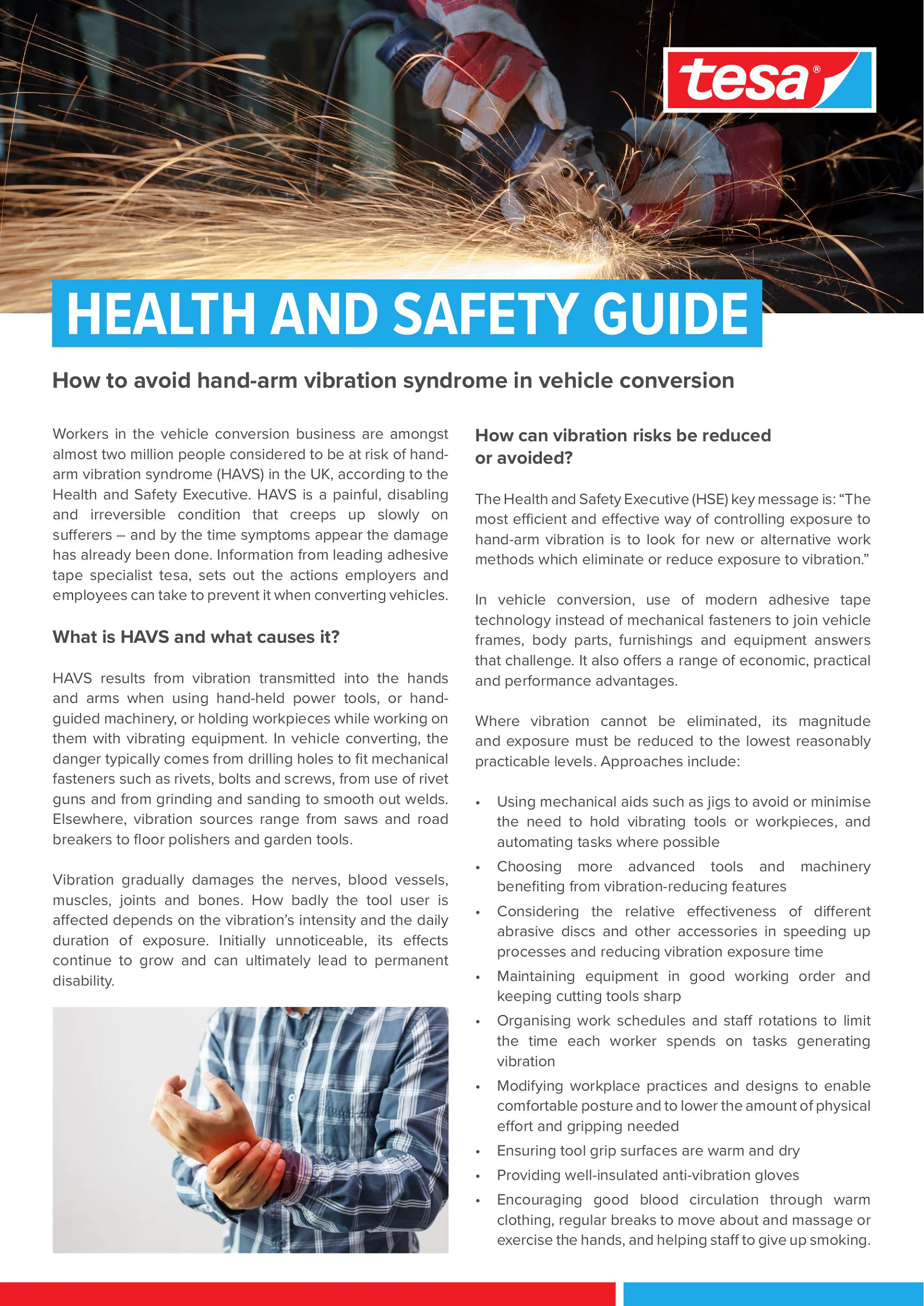Workers in the vehicle conversion business are amongst almost two million people considered to be at risk of hand-arm vibration syndrome (HAVS) in the UK, according to the Health and Safety Executive. HAVS is a painful, disabling and irreversible condition that creeps up slowly on sufferers – and by the time symptoms appear the damage has already been done. Information from leading adhesive tape specialist tesa, sets out the actions employers and employees can take to prevent it when converting vehicles.

Health and Safety Guide
Technologies
How to avoid hand-arm vibration syndrome in vehicle conversion
What is HAVS and what causes it?
HAVS results from vibration transmitted into the hands and arms when using hand-held power tools, or hand-guided machinery, or holding workpieces while working on them with vibrating equipment. In vehicle converting, the danger typically comes from drilling holes to fit mechanical fasteners such as rivets, bolts and screws, from use of rivet guns and from grinding and sanding to smooth out welds. Elsewhere, vibration sources range from saws and road breakers to floor polishers and garden tools.
Vibration gradually damages the nerves, blood vessels, muscles, joints and bones. How badly the tool user is affected depends on the vibration’s intensity and the daily duration of exposure. Initially unnoticeable, its effects continue to grow and can ultimately lead to permanent disability.
How can vibration risks be reduced or avoided?
The Health and Safety Executive (HSE) key message is: “The most efficient and effective way of controlling exposure to hand-arm vibration is to look for new or alternative work methods which eliminate or reduce exposure to vibration.”
In vehicle conversion, use of modern adhesive tape technology instead of mechanical fasteners to join vehicle frames, body parts, furnishings and equipment answers that challenge. It also offers a range of economic, practical and performance advantages.
Where vibration cannot be eliminated, its magnitude and exposure must be reduced to the lowest reasonably practicable levels. Approaches include:
- Using mechanical aids such as jigs to avoid or minimise the need to hold vibrating tools or workpieces, and automating tasks where possible
- Choosing more advanced tools and machinery benefiting from vibration-reducing features
- Considering the relative effectiveness of different abrasive discs and other accessories in speeding up processes and reducing vibration exposure time
- Maintaining equipment in good working order and keeping cutting tools sharp
- Organising work schedules and staff rotations to limit the time each worker spends on tasks generating vibration
- Modifying workplace practices and designs to enable comfortable posture and to lower the amount of physical effort and gripping needed
- Ensuring tool grip surfaces are warm and dry
- Providing well-insulated anti-vibration gloves
- Encouraging good blood circulation through warm clothing, regular breaks to move about and massage or exercise the hands, and helping staff to give up smoking.
How can tesa help?
As mentioned earlier, vehicle converters using welding or mechanical fasteners to connect parts and materials need power tools to clean up welds and to drill holes and to apply rivets. Adhesive tapes offer an effective alternative that avoids the vibration, noise, discomfort and safety risks of power tool use.
In contrast to mechanical fixing, which is a multi-stage process with high time and energy demands, adhesive tapes bond and seal in a single, quick operation. Rather than weakening joined structures with welds and holes, adhesive tapes spread the load across the whole contact surface. They also join panels and components without spoiling the vehicle’s aesthetics, as there are no visible weld seams or rivet, bolt and screw heads.
Tapes are available with adhesive and structural configurations to bond many different materials and to meet other difficult challenges. That includes bonding all common vehicle materials, or combination of materials, even with very different thermal expansion and contraction rates. There are adhesive tape specifications for filling and sealing gaps, maximising strength and standing up to chemicals, vibration and extreme temperature variation, to name but a few. All these benefits are gained on top of preventing HAVS.

Looking for More Information?
For further information on vibration, follow the links on the HSE website:
http://www.hse.gov.uk/vibration/hav (opens in a new window or tab)
To support the Control of Vibration at Work Regulations 2005 the HSE have produced a calculator to assist in calculating exposures for hand-arm vibration. To find out if you effected by Hand Arm Vibration Syndrome click here: https://www.hse.gov.uk/vibration/hav/vibrationcalc.htm (opens in a new window or tab)
